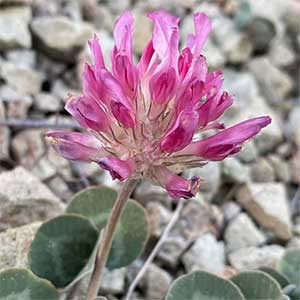Trifolium owyheense
Trifolium repens
Owyhee clover
Dutch clover, trèfle blanc, white clover
cespitose, spreading, branched proximally, sparsely branched distally.
creeping, branched, rooting at nodes.
palmate;
stipules broadly obovate, 1–2 cm, fused at base, margins slightly lobed, apex acute;
petiole 2–6 cm;
petiolules 1–1.5 mm;
leaflets 3, blades ovate, obovate, or orbiculate, slightly overlapping, 1–2 × 0.7–2.3 cm, base truncate to rounded, veins prominent, margins sparsely dentate, apex rounded, emarginate, surfaces glabrous.
palmate;
stipules lanceolate, 0.9–1.3 cm, margins entire, apex short-subulate;
petiole 5–20 cm;
petiolules to 1 mm;
leaflets 3, blades obovate, obcordate, or orbiculate, 0.6–4 × 0.4–2.5 cm, base cuneate, veins moderately prominent, margins serrulate distally, apex rounded, emarginate, or retuse, surfaces glabrous.
terminal, 20–30-flowered, globose, usually formed of 2 sessile heads, 2.5–5 × 2.5–5 cm;
involucres absent.
axillary, 20–40+-flowered, globose, 1.5–3.5 × 1.5–3.5 cm;
involucres absent.
3–7 cm, surpassing subtending leaves.
erect, from prostrate stems, 1.5–30 cm.
erect, reflexed in proximalmost flowers, 1 mm;
bracteoles cuplike, 0.5 mm.
strongly reflexed in fruit, elongate, 3–5 mm;
bracteoles white, lanceolate, 1–2 mm.
15–21 mm;
calyx tubular-campanulate, 9–12 mm, pilose, veins 10, tube 4.5–6 mm, lobes subequal, abaxialmost longest, subulate, orifice open;
corolla deep pink or magenta, 20–23 mm, banner tubular for most their length, 18–22 × 5–7 mm, apex flared.
8–13 mm;
calyx campanulate, 3–5 mm, glabrous, veins 6–10, tube 1.5–2.5 mm, lobes unequal to subequal, adaxial shorter than tube, triangular-lanceolate, orifice open;
corolla white, often pinkish in age, 4–12 mm, banner ovate-lanceolate or oblong, 4–12 × 1–4 mm, apex rounded.
ellipsoid, 4–5 mm.
linear-oblong, 4–5 mm.
1 or 2, yellow-mottled, mitten-shaped, 2–3 mm, smooth.
3 or 4, yellow, reddish brown, or light brown, ovoid-reniform, 1 mm, smooth, glossy.
= 16, 28, 32, 48, 64.
Trifolium owyheense
Trifolium repens
Trifolium owyheense is known from about 40 populations in a small portion of east-central Malheur County in Oregon, and immediately adjacent Owyhee County in Idaho (M. Mancuso 2001).
(Discussion copyrighted by Flora of North America; reprinted with permission.)
Trifolium repens may very well be the most important temperate pasture plant (M. J. Baker and W. M. Williams 1987) and has been considered the most important perennial pasture plant in North America (C. V. Piper 1924). It was introduced at least as early as the mid 1800s (R. N. Mack 2003) and spread so rapidly that it became known to Native Americans as White Man’s Foot Grass (W. Strickland 1801). It is morphologically diverse; most material from the flora area represents var. repens, but some specimens fit within the circumscriptions given by M. Zohary and D. Heller (1984) of var. giganteum Lagrèze-Fossat, with inflorescences to 3.5 cm diameter and leaflets nearly 4 cm; others have smaller, pale-pink petals with hairy petioles and pedicels, and approach var. biasolettii (Steudel & Hochstetter) Ascherson & Graebner (T. occidentale Coombe).
(Discussion copyrighted by Flora of North America; reprinted with permission.)
- Local floras:
BC,
CA,
OR,
WA
- Local Web sites:
CalFlora,
CalPhotos,
Flora NW,
Go Botany,
IL Wildflowers,
KS Wildflowers,
LA Plants,
MD Biodiversity,
MI Flora,
MN Wildflowers,
MO Plants,
PNW Herbaria,
SW CO Wildflowers,
Turner Photog.
WildflowerSearch
iNaturalist (observations)
USDA Plants Database
- LBJ Wildflower Center
- SEINet
- Plants of the World Online
- Encyclopedia of Life
- Wikipedia
- Google Image Search


